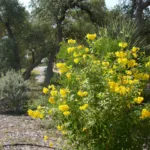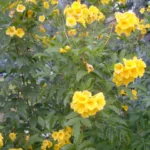Spring began on March 20th. To celebrate the change of season, the Kerrville
and Fredericksburg NPSOT chapters are promoting the Esperanza (Tecoma stans) at local nurseries as part of the N.I.C.E. Native Plant Partner program. (N.I.C.E. stands for “Natives Improve and Conserve Environments.”)
 Esperanza, also known as “yellow bells” and “yellow trumpet,” is a native shrub with a tropical feel. Call it eye candy for your summer landscape – if you get it planted during the spring! Esperanza is seen all over the Hill Country, listed and pictured in every single landscape book around Austin or San Antonio, because of its long bloom time, heat tolerance, and low water use.
Esperanza, also known as “yellow bells” and “yellow trumpet,” is a native shrub with a tropical feel. Call it eye candy for your summer landscape – if you get it planted during the spring! Esperanza is seen all over the Hill Country, listed and pictured in every single landscape book around Austin or San Antonio, because of its long bloom time, heat tolerance, and low water use.
In the wild, the native esperanza will be found growing in well drained soil and full sun on rocky slopes near San Antonio and in the Trans-Pecos, north into New Mexico and Arizona, east to Florida and south into Central and South America. The species that is native to the southwestern U.S. and adjacent Mexico is Tecoma stans var. angustata, which is shorter, more drought-tolerant, and more cold-tolerant than some of the tropical varieties sold in nurseries.
South of us, esperanzas are considered almost evergreen, depending on the severity of the winter. Here in central Texas we call it a deciduous perennial – deciduous because it loses its leaves in the winter, and  perennial because it comes back every year. The first winter, however, can be stressful or even fatal to esperanzas. That is why they should be planted in the spring, to have many months of root growth before the first hard freeze. And lots of mulch over the roots during that first winter. But at this time of year, that also means waiting to plant it until AFTER our last freeze of the winter. So you might want to hold off on planting it until you feel sure it will not freeze again. Our official “average last freeze” here is April 10.
perennial because it comes back every year. The first winter, however, can be stressful or even fatal to esperanzas. That is why they should be planted in the spring, to have many months of root growth before the first hard freeze. And lots of mulch over the roots during that first winter. But at this time of year, that also means waiting to plant it until AFTER our last freeze of the winter. So you might want to hold off on planting it until you feel sure it will not freeze again. Our official “average last freeze” here is April 10.
GOLD STAR ESPERANZA SPECIFICATIONS AT A GLANCE
Exposure: Full sun (will tolerate afternoon shade)
Size: 4-9 feet high
Planting time: Spring, after the threat of a freeze has passed
Soil type: Extremely easy to grow in alkaline to acidic, well-drained soils
Suggested uses: Use esperanza as a single specimen or plant it in groupings for a large swath of color.
Special notes: Esperanzas tolerate very high temperatures and drought – once established – but they do not tolerate poorly drained soils. During its first year, irrigate regularly, every week to 10 days, allowing plants to dry out between waterings.
WHERE TO FIND IT
Our local NICE nurseries have happily agreed to stock up on our Plant of the Season in order to have it available to the public. These independent nurseries carry only the best plants for our area, as well as high-quality soil amendments and gardening supplies.
Look for the “NICE Plant of the Season” sign stake at these nurseries and growers in Fredericksburg, Medina, Kerrville, and Comfort:
Friendly Natives, 1107 N. Llano Street, Fredericksburg, 830-997-6288
Medina Garden Nursery, 13417 Tx. Highway 16, Medina, 830-589-2771
Natives of Texas, 4256 Medina Highway, Kerrville, 830-896-2169
Plant Haus 2, 604 Jefferson Street, Kerrville, 830-792-4444
The Gardens at The Ridge, 13439 S. Ranch Road 783 (Harper Rd.), Kerrville, 830-896-0430
The Garden Haus, 109 Farm to Market Rd. 473, Comfort, 830-995-5610
Cindy Anderson, Kerrville chapter – for N.I.C.E. plants
